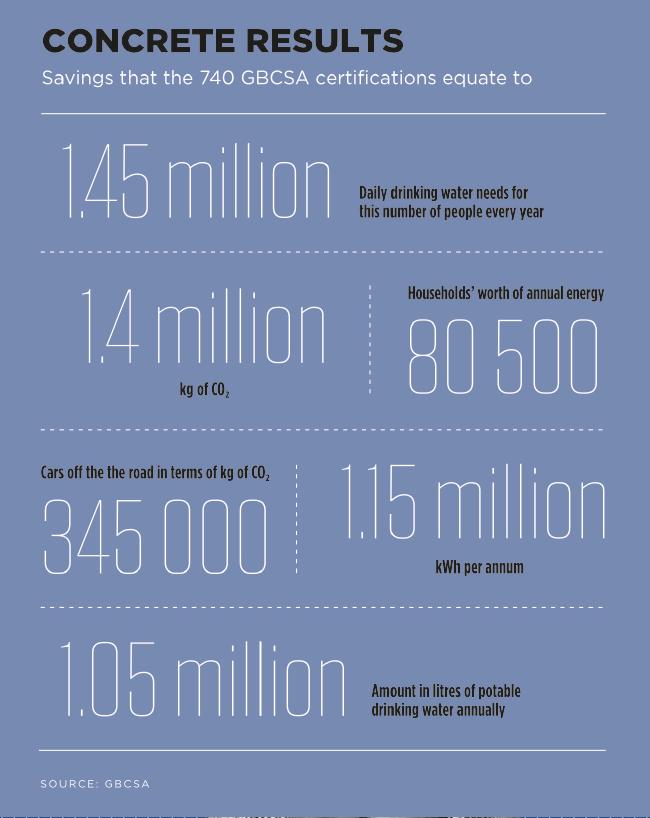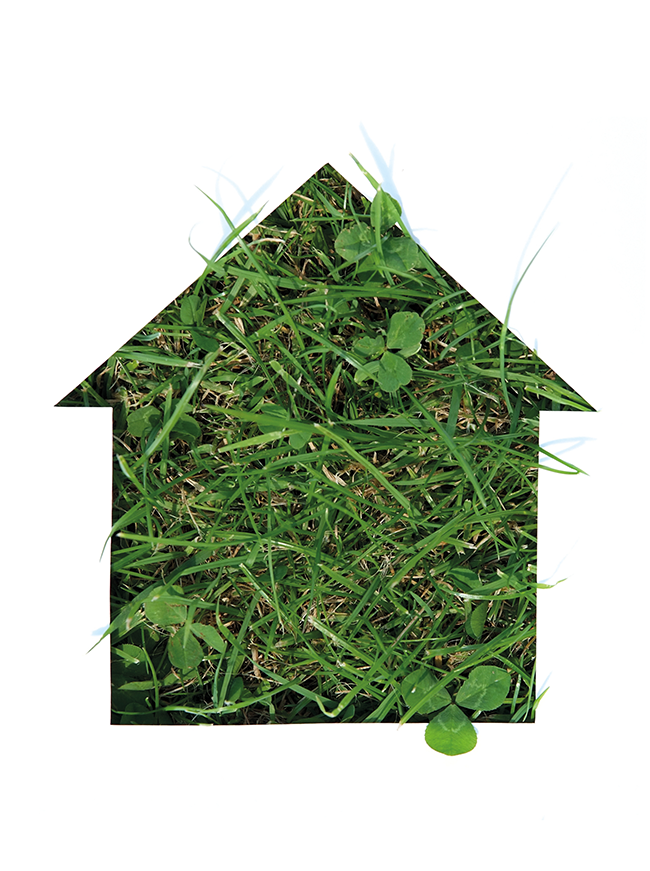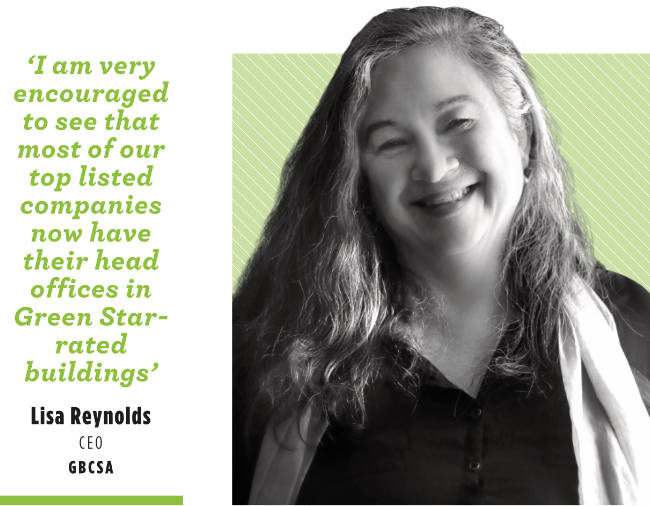The green building movement in SA is thriving – thanks to Corporate SA being one of the key driving forces. Some of the top JSE-listed companies were the first to adopt green certifications when the Green Building Council South Africa (GBCSA) introduced them more than a decade ago and created a demand for green office space – and, lately, also for residential and industrial certifications. A small group of corporates, including listed property companies, have achieved the highest Green Star certification available: a 6-star ‘as built’ rating, which places their buildings in the ‘world leadership’ category.
Discovery’s striking new Sandton HQ is one of these. The energy- and water-efficient smart building is an eye-catcher because of its shiny, curved facade (or, in architectural terms, ‘high-performance double-glazed curtain wall’). It was designed around the company’s core business of health and wellness, and aims to boost employee productivity through an innovative layout that favours staircases over elevators and includes a green rooftop with a running track, gym, yoga deck and sports courts.
Cape Town’s V&A Waterfront is home to several 6-star Green Star-rated buildings, including No 1 Silo (occupied by Allan Gray), No 5 Silo (PwC and Werksmans Attorneys), and the Ridge (Deloitte). The latter incorporates 12 000 ecobricks, made from 2-litre plastic bottles filled with discarded plastic, to save on concrete (which has high-embodied carbon) and to help repurpose waste.
Despite the challenges of COVID-19, the GBCSA issued 140 certifications in 2021, compared to 103 in 2020 and 87 in 2019. SA’s current total of 740 certified green buildings covers an area equivalent to 1 650 rugby fields and saves carbon emissions equal to removing 345 000 cars from the roads every year. The ambitious goal is to achieve net zero carbon for all new buildings by 2030 and for all existing buildings by 2050.

‘I am very encouraged to see that most of our top listed companies now have their head offices in Green Star-rated buildings. This is often due to the major listed property companies which provide the spaces to locate their offices in,’ according to Lisa Reynolds, CEO of the GBCSA. ‘It’s also these listed companies that have to compile ESG reports and, of course, being in a certified Green Star-rated building is a good way to show that you are paying attention to the environmental impacts of your property footprint. Because there’s still no mandatory green building regulation at present, the corporate and government buildings that have achieved Green Star ratings have done so voluntarily,’ she says. ‘As such, green building in South Africa really has been driven forward by those progressive companies and government departments that understand the benefits that greening their property portfolios will have – be those environmental, financial or health benefits.’
The benefits for people are obvious… Green buildings offer occupants better air quality and thermal comfort, which boosts their mental well-being, cognitive scores and productivity. Green buildings are better for the planet, because they use less electricity and water and fewer natural resources than conventional buildings, and can even be net positive by generating a surplus of renewable energy and increasing biodiversity.
Green buildings also yield better profits. During the pandemic, green-certified prime and A-grade offices outperformed their non-certified counterparts in terms of vacancy and return rates, according to the MSCI 2020 SA Green Annual Property Index. Certified properties had a 31% higher capital value per square metre, which highlights why investors consider sustainable, resource-efficient buildings to be lower risk.
The investment community is buying into ‘going green’, with more and more emphasis being placed on green buildings, including energy and water efficiencies.
Investec Property Fund (IPF) was the country’s first REIT (real estate investment trust) to issue a sustainability-linked ESG bond in Africa, tied to their ESG strategy – predominantly the roll-out of solar PV and green buildings. The fund was able to raise a three-year unsecured bond of R800 million at a competitive coupon rate, and re-finance existing debt and release security, thereby enhancing the quality of the IPF balance sheet.

‘This issuance speaks to the underlying synergies within our portfolio and to the broader ESG priorities entrenched in the fund,’ says Darryl Mayers, IPF joint CEO. ‘As a pioneer in the sector, we intend to hold ourselves accountable to our prescribed targets. With our commitment to ESG we can motivate and inspire the private sector to do the same. We have the ability to positively influence and assist tenants, and we can fund overall awareness by supporting the GBCSA and other stakeholder groups.’
While property owners still pay slightly more to build green, they soon recoup the extra outlay through the operational savings and higher return rates. In fact, the cost premium for green buildings in SA has been shrinking – from a median of 5.95% in 2009 to currently 3.15%, according to Danie Hoffman, senior lecturer at the University of Pretoria’s department of construction economics and programme leader in quantity surveying.
‘The most dramatic change has been at the top end of the market, where the big corporates sit,’ he says, adding that for high-end buildings with a base cost of more than R22 500/m2, the green building premium has dropped from 8.72% in 2014 to currently just more than 3%. This is due to the professional teams having gained experience in building more cost-effectively and to green materials becoming more widely available. ‘The industry is changing. A few years ago you had to pay a cost premium if you wanted to use recycled steel. These days that’s the only steel you can buy, so there’s no extra cost,’ says Hoffman. ‘The cost of green building is getting very close to that of conventional building, and if you take out the certification fees, there is almost no premium anymore. There’s also hardly any cost difference between designing and building a 4-star as opposed to a 5-star-rated green building.’
Marloes Reinink, founder and director of sustainable building consultancy Solid Green, believes that to achieve its climate commitments, SA needs to move to 6-star-rated buildings and beyond that – into net zero, regenerative or living buildings that actually improve the environment. ‘We need to keep pushing for higher sustainability goals, which I see happening in the huge focus on ESG issues, and this is likely to filter through to buildings and building operations,’ she says.
‘The efficient running of buildings is also going to be more prominent, because it’s one thing to build a green building but a totally different thing to operate one. The savings do not magically appear – you can run a very efficient building very inefficiently.’
From December 2022 onwards, it will become mandatory for non-residential buildings to have an energy performance certificate (EPC). The idea is that measuring and disclosing the consumption patterns of buildings will lead to improved energy use, which is a prerequisite to achieving net zero carbon.
Growthpoint Properties, the owner of the continent’s largest portfolio of green-certified office buildings, is one of the companies that have been instrumental in SA’s green building movement. The JSE-listed company recently announced its sole sponsorship of the new GBCSA Green Star Existing Building Performance (EBP) rating tool pilot for existing industrial buildings.
‘This is a first for the industry and the country, which has the potential to radically improve sustainability in the industrial property sector,’ says Grahame Cruickshanks, Growthpoint’s head of sustainability and utilities. ‘Future-proofing industrial assets for the impacts of climate change and increasing costs of energy, water, waste and emissions plays a key role in the ongoing smooth running of national and regional economies, in addition to delivering a range of other benefits. The tool will be made available to the entire South African property industry for all to use.’
He adds that it’s important to not only push the envelope on new building projects, but also to simultaneously improve the performance of existing assets. ‘The diversity of building types and tenant needs in the industrial sector requires careful alignment with the new rating tool but once complete we anticipate transformative impact on buildings through supply chain impact, performance benchmarking and asset valuations.’
The GBCSA offers discounted rates for bulk certifications, which at Growthpoint mainly apply to EBP Green-Star certifications for office buildings as well as re-certifications (required every three years). The company takes a portfolio-wide approach to the certifications of its office properties and plans to reach the same point with its industrial portfolio.
In a similar approach, Liberty Two Degrees achieved EBP Green Star ratings for its entire shopping-centre portfolio, and Balwin Properties has bulk-registered more than 30 000 apartments across its portfolio for certification with the GBCSA – although this is not for Green Star but for EDGE certification.
EDGE is a cost-effective international planning tool for energy and water efficiency through which Balwin wants to provide low- to middle-class buyers and tenants with access to greener homes. ABSA and FNB are already offering ‘eco’ home loans at reduced rates for properties that are certified in this way. These examples illustrate how the green building movement continues to gain momentum, making the country’s property sector greener, healthier, and more sustainable in its quest for net zero.









